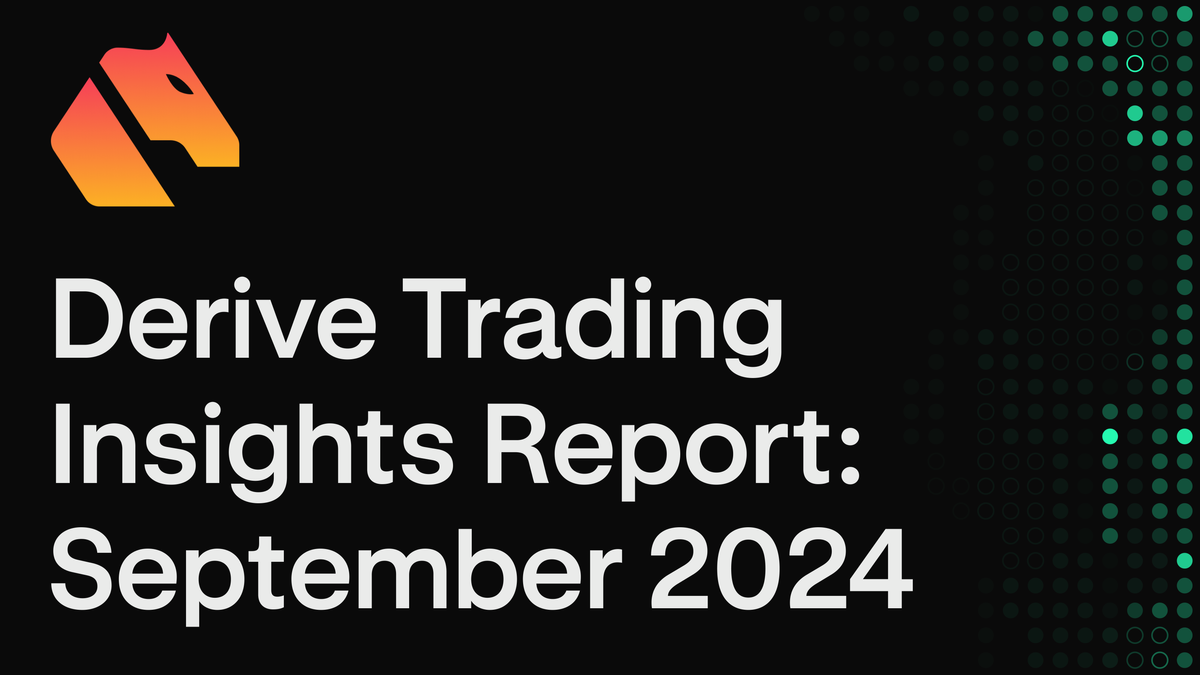Derive Trading Insights Report: September 2024


Introduction
I'm excited to share our inaugural Derive Trading Insights Report: September 2024, as we track key market trends across open interest movements, volatility metrics, realized vs. implied volatility, and options trading strategies for ETH and BTC.
We also dive into the performance of the vaults products on Derive, including covered call strategies, providing traders with new tools for leveraging assets and generating yield in DeFi.
The September report reveals growing bullish sentiment in both ETH and BTC options markets. Notably, ETH traders were capping their expectations for upside, while BTC remained neutral with significant open interest at key strike prices like $75k and $100k.
Implied volatility (IV) for ETH was at 52% and 45% for BTC for September, with realized volatility lower, signaling strong demand for upside leverage. The vaults performed exceptionally well, generating over $149k for ETH vault depositors, while new features like Lombard BTC vaults and Derive Borrow highlight our commitment to expanding DeFi capabilities.
As we move closer to the U.S. election and navigate an evolving market, we look forward to continuing to provide valuable insights and innovative tools that empower users to make informed trading decisions.
– Nick Forster, Founder of Derive
Open interest: Bullish sentiment ahead of the U.S. election
At the end of September, call options dominated the live open interest for both Ethereum (ETH) and Bitcoin (BTC), indicating a largely bullish sentiment as the U.S. election approaches.
- BTC:
- Large open interest at the 75k and 100k strike prices highlights these as key levels that could either act as barriers or points of breakout for price movements
- BTC shows roughly equal distribution of calls and puts being bought and sold, suggesting a neutral overall sentiment
- ETH:
- ETH has nearly 2.5x the number of calls sold compared to calls bought, indicating that traders may believe the upside potential for ETH is capped
- The relatively small number of calls bought further supports the notion that ETH’s potential for significant price gains may be limited in the near-term
“The dominance of calls in both ETH and BTC open interest reflects a growing optimism leading up to the U.S. election. BTC’s open interest at the 75k and 100k strikes shows that traders are positioning for significant movement, which could act as key barriers or breakout levels,” said Nick Forster, Founder of Derive.
“Interestingly, the skew in ETH open interest, with nearly 2.5-times more calls sold than bought, suggests that traders see the upside as limited for now. This divergence between the two assets will be key to watch as we get closer to election day.”
Realized and Implied Volatilities
In terms of volatility, both BTC and ETH present similar trends:
- BTC’s at-the-money (ATM) implied volatility (IV) has remained steady at approximately 45% annualized, while ETH’s IV sits at around 52%
- These IV levels suggest average daily price moves of 2.4% for BTC and 2.7% for ETH
- Realized volatility, however, has dropped significantly for both assets. BTC’s realized volatility fell from 48% to 34%, and ETH saw a reduction from 62% to 40%
- The decline in realized volatility suggests that the market has been pricing options at a premium, reflecting high demand for upside and leverage in the lead-up to the U.S. election on November 8, 2024.
Longer-dated expiries:
- Longer-term volatility (90 days) has been trending slightly lower, especially for ETH, implying that markets expect calmer conditions after the election. This might signal a temporary period of heightened volatility tied to election outcomes, with stabilization expected afterward.
Nick Forster: “Despite steady ATM implied volatility, realized volatility has dropped significantly for both BTC and ETH. This means the market has been pricing in more movement than has actually materialized, a clear signal of high demand for upside exposure.
“With the U.S. election on the horizon, we’re seeing options premiums remain elevated, illustrating traders’ appetite for hedging or leveraging market swings. Interestingly, the softening of longer-dated volatility could be a sign that traders are anticipating a more stable environment after November."
Vault performance
Vault products on Derive have been the top-performing source of volatility yield within DeFi throughout September. Key results include:
- weETH covered call vault: Sold 10,266 ETH calls, generating $69,911 in profits for depositors
- rswETH covered call vault: Sold 9,090 ETH calls, producing $63,357 in profits
- rsETH covered call vault: Sold 2,321 ETH calls, earning $16,386 in profits
Derive vaults continue to return competitive yield for LRT stakers
“Derive vault strategies continued to outperform throughout September, demonstrating the power of volatility yield in DeFi. The consistent profits generated by these covered call vaults, such as the $69,911 from the weETH vault, show how users are capitalizing on elevated market demand for options.
“We’re particularly excited about the launch of Lombard BTC vaults, which provide new avenues for generating yield on BTC in the DeFi space.” – Nick Forster
New product launches
- Lombard BTC vaults: Lombard BTC vaults went live on Derive, allowing users to generate volatility yield on their LBTC holdings. This new product provides BTC holders with another way to earn yield within the DeFi space
- Derive Borrow: Derive has also introduced a new borrowing product that allows users to borrow USDC at an attractive 2.8% interest rate, which is the lowest rate available in DeFi at the time of publication
- Supported collateral includes popular assets like LRTS (weETH), yield-generating stablecoins (sUSDe), and staked BTC (cbBTC). These assets can also be used as collateral for options trading, a unique feature not offered by other platforms
- Notably, many of these collateral options, such as rswETH and LBTC, are not accepted for borrowing on other major platforms, giving Derive a competitive advantage.
Derive Borrow offers competitive rates on a diverse selection of collaterals
Nick Forster: “The launch of Derive Borrow marks a pivotal moment for the protocol. Offering users the ability to borrow USDC at rates as low as 2.8%, well below what’s available on major lending platforms, highlights our commitment to delivering best-in-class DeFi products.
“Derive Borrow allows traders to use yield-generating and staked assets as collateral – something you won’t find on most platforms. This gives our users a critical edge in both borrowing and trading strategies.”
Conclusion
As the crypto market approaches the U.S. election, the dominance of call options and the significant divergence between realized and implied volatilities reflect traders' anticipation of heightened price movements. Ethereum’s capped upside sentiment and Bitcoin’s neutral positioning suggest a mixed outlook for the two leading cryptocurrencies.
With strong vault performance and the introduction of new products, Derive continues to cement its place as a leader in DeFi, providing unique opportunities for traders and yield seekers alike.
